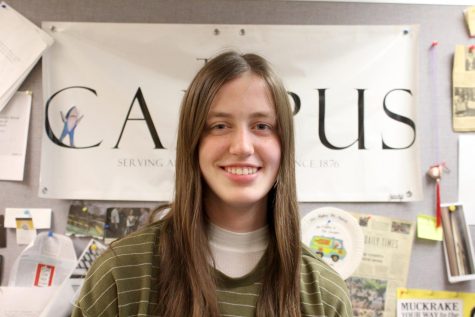SEA to host 11th annual Trashion Show
Spring 2023 fashion prediction: Trash is the new black. As Friday, April 14, approaches, students from clubs across campus prepare to showcase their creative talents at Students for Environmental Action’s annual Trashion Show.
“Some people are working on making … an outfit entirely out of Monster cans,” said SEA Secretary Elsa Waidelich, ’25. “I’m just so curious to see how it’s gonna work out.”
For its second show after COVID-19, SEA is trying to ramp up student engagement. The show also hopes to bring more awareness of the dangers of fast fashion — defined by Ecowatch.com as clothes that are mass produced using cheap materials and typically thrown out not long after being purchased.
“It doesn’t totally resolve the trash problem, right?” Waidelich asked. “Unless you’re really good at your crafting, it’s not always something you really wear on a regular day-to-day basis … (but) even if you don’t keep (the outfit), it got a second use anyways.”
As the winner of the 2022 Trashion Show, Waidelich shared some advice for future participants. Namely, do not be afraid to join in, even if you have no previous experience. The Trashion Show is low-stakes and more about raising awareness and celebrating the works of others rather than competing to see who has the best outfit, Waidelich explained. This was the exact advice that ESS and Spanish double major Elizabeth Dyer, ’25, said she wished she had heard last year.
“I wish I knew that I could do it,” Dyer said. “Last year, I was like, ‘I don’t know how to make anything so I’m not gonna mess with it.’ But I wish that I knew that I could have at least tried and even if it didn’t work out, who cares? No one’s going to like be mad at me for not making something.”
As a member of SEA, Dyer decided to stop by during one of the Trashion meetings this year to try it out. Upon looking at the materials, Dyer explained, “my design literally just fell in my lap.” For the show, Dyer has been working on constructing a skirt out of old cartoons from newspapers.
“I used to read them growing up and then I was like, ‘oh, man, we could kind of put these together and make (a skirt),’” Dyer said.
Working with trash has been a lot easier than Dyer anticipated. She had no formal experience with crafting clothes in general and was worried about the cleanliness of the trash. However, after getting started the whole process was a blast.
“Plastic is much more durable, more flexible, than fabric,” Dyer said. “So I think that’s kind of an unforeseen advantage to using different materials because you can kind of pick what works best for you.”
The designs for the show have been a collaborative effort for the most part. At SEA meetings, students work together to craft pieces of fashion out of trash. Not only are SEA members working with each other, but this year Knitting Club has also volunteered its resources and services to the event. Ella Lunney, ’23, Knitting Club president, explained how the club has been working with SEA these past few weeks in preparation for the show.
“We’re basically just providing any supplies like (plarn) or (helping out) if anyone needs any help with a pattern that they’re working on for the show,” Lunney said.
Plarn is a term for plastic yarn. Constructed by cutting up plastic bags into strips and weaving them together, Knitting Club produced these during a number of both private and public meetings over this past year.
On top of helping others with their looks, Lunney decided to give her own design a shot. It is still in the works, but she is working on a skirt combo with a cardboard corset top. For Lunney, the process has been very exciting.
“I’m really excited to see how everything else is coming together because I’ve heard snippets of what other people are doing, what patterns they’re planning to use and how they plan to put things together,” Lunney said.
For those intimidated by the process, both Lunney and Dyer stressed how laid-back constructing the clothes has been. Trashion designers come from all different skill levels and everyone works together to reuse trash that has been produced on campus in meaningful ways.
“The nice thing about working with Trashion on is you are working with recycled material,” Lunney said. “You’re working with trash. So if you have to scrap something, that’s the whole point of the show.”
As Dyer reflected, taking part in Trashion has made her reevaluate some life choices. Trash transitioned from something to be disposed of to something that has value and can be reinvented in a number of ways.
“So now I look at all the GFC stuff and I’m like, ‘oh, like what could be cut off and like made into something cool?’” Dyer said.
For those interested in joining, there is still time. SEA is hosting Trashion workshops on Wednesdays from 6-8 p.m. in McKinley’s Private Dining Room as well as during their regular meetings on Thursdays from 7-8 p.m. in Carr Hall 238. Waidelich encouraged anyone interested to email SEA to get involved.
“It’s trash,” Dyer said. “It just wants to be used in some way.”

Caroline Maye is a first year from Chicago, Illinois. She plans to major in Political Science or History with a minor in Journalism in the Public Interest....








